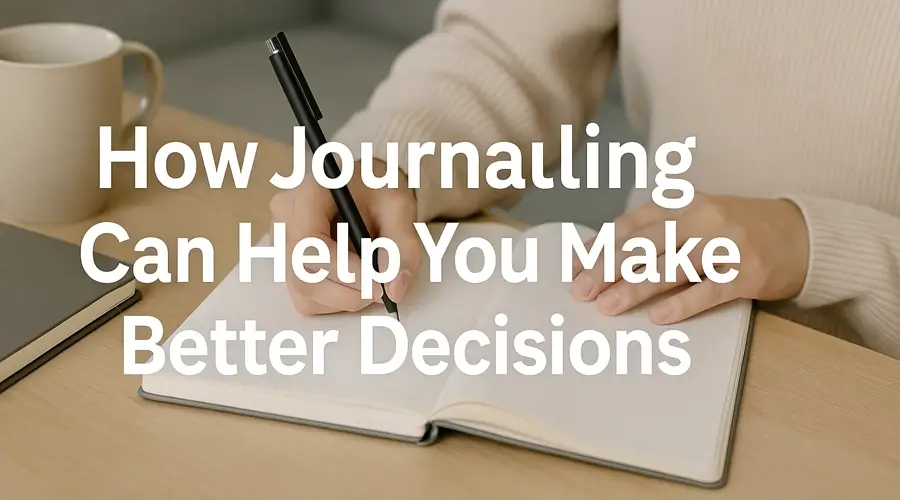In a world that constantly demands our attention, stress and anxiety have become almost inevitable companions. Whether it’s the pressure of work deadlines, personal challenges, or simply the overwhelming nature of modern life, finding ways to manage these emotions is essential. Among various self-care techniques, Journaling for stress relief has emerged as a powerful and accessible practice, offering a safe space to process thoughts, regulate emotions, and regain mental clarity.
This article will explore how journaling can be a game-changer for managing stress and anxiety. You’ll discover the science behind it, different journaling techniques that work, and practical strategies to start and maintain a meaningful journaling habit. Whether you’re new to the practice or looking to deepen your existing routine, this guide will provide actionable insights to help you turn your journal into a tool for emotional resilience and self-discovery.
Why Does Journaling Work for Stress and Anxiety?
We all experience moments when our thoughts feel like a tangled mess—overwhelming, scattered, and difficult to make sense of. This mental chaos is a major contributor to stress and anxiety. Journaling for stress relief works because it gives our thoughts structure, allowing us to process emotions in a way that reduces their intensity and helps us regain clarity.

How Writing Engages the Brain in a Structured Way
When we write, we activate the prefrontal cortex, the part of the brain responsible for rational thinking and decision-making. This helps shift our minds from reactive emotional states (often controlled by the amygdala) to a more logical and organized approach. In other words, writing forces our brains to slow down, organize information, and make sense of what we’re feeling.
By putting words to emotions, we essentially externalize our inner turmoil, making it easier to process. Instead of allowing stressful thoughts to loop endlessly in our heads, journaling provides a concrete way to see, analyze, and reframe them. This structured reflection allows us to gain insight into our triggers, patterns, and responses—an essential step toward managing stress and anxiety effectively.
The Science Behind Journaling: How It Affects Stress and Anxiety
Several scientific studies have explored the physiological benefits of journaling, particularly its impact on stress regulation. One of the key findings is its effect on cortisol levels—the hormone responsible for the body’s stress response.
- Journaling reduces stress hormone levels: A study published in the journal Psychosomatic Medicine found that individuals who engaged in expressive writing (writing about emotions and personal experiences) showed lower cortisol levels over time compared to those who didn’t. Lower cortisol levels are linked to a calmer nervous system and improved emotional resilience.
- Improves emotional regulation: Writing about stressful experiences allows the brain to process emotions more effectively, reducing their grip on the mind. In fact, research suggests that individuals who regularly journal experience fewer symptoms of anxiety and depression.
- Enhances problem-solving skills: When we write about a stressful situation, we naturally begin to analyze it from different perspectives. This encourages cognitive restructuring—the ability to reframe negative thoughts into more constructive, manageable ones.
Journaling vs. Venting: Why Structured Reflection Matters
It’s easy to assume that journaling is just another form of venting, but the two are quite different. Venting often involves an unfiltered emotional release, where thoughts are poured out onto the page in an unstructured manner. While this can feel cathartic in the short term, it doesn’t necessarily help in long-term emotional regulation.

On the other hand, effective journaling goes beyond venting—it involves structured reflection. This means:
- Recognizing and naming emotions rather than just reacting to them.
- Identifying thought patterns and recurring stressors.
- Exploring solutions and alternative perspectives instead of dwelling on negativity.
For example, instead of simply writing:
“I feel anxious all the time, and I don’t know why.”
A more structured journaling approach might look like:
“I feel anxious today because I have an important meeting. I’ve had similar feelings before, and in those cases, preparing well helped reduce my stress. Maybe I can make a checklist to feel more in control.”
This slight shift in approach makes a huge difference. Instead of getting trapped in a cycle of negative emotions, structured journaling helps create a roadmap for managing them.
The power of Managing anxiety with journaling lies in its ability to bring clarity to the chaos of the mind. Writing not only helps you express what you’re feeling, but also encourages you to make sense of it—transforming overwhelming emotions into insights that promote healing, resilience, and self-awareness.
Different Types of Journaling for Anxiety and Stress Management
Journaling is not a one-size-fits-all practice. Different techniques serve different purposes, and finding the right approach can make a significant impact on your mental well-being. Whether you’re looking to release emotions, reframe negative thoughts, or cultivate self-awareness, there’s a journaling method that aligns with your needs. Below are five powerful journaling techniques designed specifically for Managing anxiety with journaling and relieving stress.
1. Expressive Journaling: Releasing Emotions Without Self-Censorship
If your mind feels cluttered with stress, doubts, or racing thoughts, expressive journaling can serve as an emotional detox. This technique involves writing freely and unfiltered—allowing your thoughts to flow onto the page without worrying about grammar, structure, or coherence.

Why It Works:
- Helps process suppressed emotions rather than letting them build up.
- Provides a safe space to express worries and frustrations without judgment.
- Prevents emotional overload by externalizing thoughts.
How to Do It:
- Set a timer for 10–15 minutes and write continuously without stopping.
- Don’t edit or second-guess what you’re writing—just let the words flow.
- If you’re stuck, start with: “Right now, I feel…” and see where it takes you.
- When finished, you can choose to keep, shred, or burn the pages—whatever feels most cathartic.
2. Gratitude Journaling: Shifting Focus to the Positive
When stress and anxiety dominate your thoughts, it’s easy to overlook the good in your life. Gratitude journaling is a simple yet powerful way to rewire your brain to focus on positivity.
Why It Works:
- Shifts attention away from stressors and toward what’s working in your life.
- Activates the brain’s dopamine and serotonin systems, improving mood.
- Helps cultivate resilience by acknowledging small joys and wins.
How to Do It:
- Every day, list 3–5 things you’re grateful for. They can be big (career progress) or small (a good cup of coffee).
- Be specific. Instead of “I’m grateful for my job,” write “I’m grateful for the supportive colleague who helped me today.”
- Reflect on why each item matters—this deepens the emotional impact.
3. Cognitive-Behavioral Journaling: Restructuring Negative Thought Patterns
This method is rooted in Cognitive-Behavioral Therapy (CBT) and helps identify, challenge, and reframe negative thoughts. Anxiety often thrives on distorted thinking patterns, such as catastrophizing (“Everything will go wrong”) or self-criticism (“I’m not good enough”). By journaling through these thoughts, you can replace them with more balanced perspectives.
Why It Works:
- Helps break cycles of negative self-talk and irrational fears.
- Encourages self-awareness by identifying thought distortions.
- Provides a structured way to reframe anxious thoughts into constructive ones.
How to Do It:
- Write down the negative thought. (“I’ll mess up my presentation and embarrass myself.”)
- Challenge its accuracy. Ask yourself: Is there real evidence for this belief? What’s the worst that could happen?
- Reframe the thought. Replace it with a more constructive one:
“I’ve prepared well, and even if I make a small mistake, it won’t define my entire presentation.”
4. Mindfulness Journaling: Cultivating Presence and Self-Awareness
Mindfulness journaling is about observing your thoughts and feelings without judgment. Instead of trying to “fix” anything, this practice allows you to be present with your emotions—helping reduce anxiety by preventing overthinking about the past or future.
Why It Works:
- Trains your mind to focus on the present moment.
- Reduces over-identification with negative thoughts.
- Enhances self-awareness and emotional intelligence.
How to Do It:
- Write a stream-of-consciousness entry describing your current state: What emotions am I feeling right now? Where do I feel tension in my body?
- Use mindfulness prompts like:
- What sensations am I experiencing in this moment?
- What is one thing I can appreciate about today?
- If my emotions had a color, what would they be?
- Keep your tone curious and non-judgmental—this isn’t about solving problems, just observing.
5. Future-Self Journaling: Rewiring Your Mindset for Growth
Future-self journaling is a visualization technique where you write as if you’ve already overcome your current challenges. This practice helps shift your focus from stress to solutions, reinforcing self-belief and positive change.

Why It Works:
- Encourages a growth mindset by focusing on progress rather than problems.
- Helps manifest confidence and resilience.
- Strengthens motivation by making goals feel more tangible and achievable.
How to Do It:
- Write from the perspective of your future self, imagining you’ve already achieved the peace, success, or growth you desire.
- Example: Instead of “I hope I get better at handling stress,” write “I’ve learned to manage stress with ease, and I feel calmer in difficult situations.”
- Use affirmations: “I am becoming someone who navigates challenges with grace and clarity.”
- Visualize specific actions your future self has taken to get there.
Each of these journaling techniques offers unique benefits, and there’s no “right” or “wrong” way to do it. Some days, you might need an emotional release through expressive writing; other days, you may benefit from structured cognitive journaling to challenge negative thoughts. The key is to experiment and see what feels most supportive for your mental and emotional well-being.
The beauty of Managing anxiety with journaling is its flexibility—it adapts to your needs, whether you’re seeking clarity, comfort, or change. So grab a pen, open a journal, and start your journey toward a calmer, more resilient mind.
How to Start a Journaling Practice for Anxiety Relief
Starting a journaling habit sounds simple—just grab a notebook and start writing, right? Yet, for many people, the hardest part is knowing where to begin. You might think, “I don’t know what to write,” or worry that your writing won’t be “good enough.” But here’s the truth: journaling is not about writing well—it’s about writing honestly. It’s a tool for self-reflection, clarity, and stress relief, not a test of literary skill.
If you’re struggling to start, this guide will help you overcome resistance, create a judgment-free space, and choose the right format for your journaling practice.
Overcoming Resistance: “I Don’t Know What to Write!”
One of the biggest roadblocks to journaling is the fear of the blank page. Many people hesitate because they feel unsure about what to write or worry their thoughts aren’t “important enough.” The key to overcoming this is to lower the pressure—your journal doesn’t have to be deep, poetic, or profound.
Here’s how to break through the resistance:
- Start small: A few sentences are enough. You don’t need to write a full page every day.
- Embrace imperfection: Your journal is a private space—nobody else will read it, so let go of self-judgment.
- Use prompts: If you’re stuck, begin with a simple question (we’ll provide prompts below!).
- Write as if you’re talking to a friend: Imagine your journal as a safe place where you can vent, reflect, or dream freely.
Creating a Judgment-Free Space for Self-Expression
Journaling is most effective when you feel safe to be completely honest. If you censor yourself, overthink your words, or judge your emotions, the process loses its healing power.
How to create a non-judgmental journaling habit:
- Write for yourself, not for others: Your journal isn’t a productivity tracker or a polished piece of writing—it’s a personal space.
- Allow all emotions to exist: Don’t filter your thoughts. If you’re feeling frustrated, anxious, or overwhelmed, let those emotions flow onto the page.
- Avoid perfectionism: Spelling mistakes, messy handwriting, incomplete sentences—none of it matters. What matters is that you’re showing up for yourself.
- If you’re uncomfortable writing about something, draw or list words instead: Sometimes, a simple mind-map or bullet points can be just as effective as full sentences.
If you’re new to journaling or struggling with what to write, prompts can help guide your thoughts. These questions encourage reflection, emotional clarity, and stress relief.
Try one of these prompts each day:
“What’s weighing on my mind right now?”
→ Helps you release anxious thoughts and gain clarity on what’s bothering you.
“What would my most compassionate self say to me?”
→ Encourages self-kindness and shifts your inner dialogue from criticism to support.
“What’s one small win I had today?”
→ Trains your brain to focus on progress and positive moments, no matter how small.
“What is one thing I can control in this moment?”
→ Reduces stress by shifting focus from what’s overwhelming to what’s actionable.
“What emotions am I feeling right now, and where do I feel them in my body?”
→ Increases emotional awareness and mindfulness, helping you tune into your body’s signals.
Starting a journaling habit for Managing anxiety with journaling doesn’t require perfection—it just requires consistency. Whether you write two sentences or two pages, what matters is that you’re showing up for yourself. Over time, journaling will become a safe space for self-reflection, clarity, and healing—a place where you can process emotions, track your growth, and reduce anxiety in a meaningful way.
So, grab a notebook or open a digital document, and start today. Your thoughts deserve a space to be heard.
In this article, we explored how Journaling for stress relief serves as a powerful tool for processing emotions, reducing anxiety, and gaining mental clarity. By externalizing thoughts and structuring emotions through writing, journaling helps regulate stress levels and promotes emotional resilience. From expressive writing that allows free emotional release to cognitive-behavioral journaling that restructures negative thought patterns, different techniques offer tailored approaches to managing anxiety effectively. The science behind journaling shows its impact on lowering cortisol levels and engaging the brain’s rational processing centers, making it a simple yet highly effective self-care practice.
Starting a journaling habit doesn’t require perfection—only consistency and honesty. Overcoming common barriers like self-judgment and writer’s block becomes easier when you create a judgment-free space and use guided prompts to initiate reflection. Whether you choose a traditional notebook or a digital format, the key is to make journaling a personal and flexible practice that supports your emotional well-being. Managing anxiety with journaling is not just about writing; it’s about giving your thoughts a voice and creating space for self-awareness, growth, and healing.
Start Journaling Smarter! Download the VerboAI APK now and let AI help you express your thoughts effortlessly.




